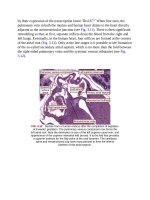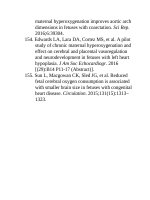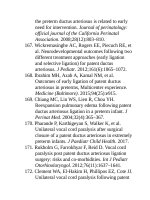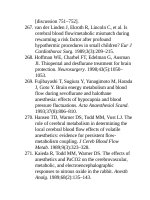Andersons pediatric cardiology 1090
Bạn đang xem bản rút gọn của tài liệu. Xem và tải ngay bản đầy đủ của tài liệu tại đây (63.53 KB, 3 trang )
detect.Oftentheclinicalfindingsarequitelabile.Iftheshuntincreases,the
murmurbecomesmoreobvious.Likethefirstgroup,itmayeventuallyspillinto
diastole.Othersignsofalargeshuntmaybepresent,includingboundingpulses,
ahyperdynamicprecordium,andtachycardia.Thisgroupofpatientstendstobe
moreimmatureandtodevelopleftventricularfailurewithrelativelysmaller
shunts.Ventilatorystatusmaydeterioratesothathigherconcentrationsof
oxygenandincreasedpressureorratesettingsarerequiredtocountera
deterioratingstatusofthebloodgases.Apneicepisodesandbradycardiaare
common.
InfantsWithLungDisease
Thisgrouptendstoincludethemostimmatureinfantswithbirthweightsless
than1000g.Usuallyventilatordependent,thedevelopmentofaleft-to-right
ductalshuntinthesepatientsisassociatedwithincreasingrequirementfor
ventilatorsupportanddeteriorationofthestatusofthebloodgases.Murmurs
maybedifficulttohear,andoccasionallyaverylargeductmaybesilent.Signs
ofalargeleft-to-rightshuntmayoccur,butleftventricularfailureisoften
difficulttodifferentiatefromsignsduetopulmonarydiseaseorsepsis.
Investigations
Neithertheelectrocardiogramnorthechestradiographisparticularlyhelpfulin
makingthediagnosisofasignificantductinprematureinfants.The
electrocardiogrammayshowleftventricularhypertrophyinthegroupwithout
lungdisease,especiallyiftheshuntissubstantialandhasbeenpresentforsome
time.Intheothertwogroups,rightventricularpredominanceismoreusual.As
mentioned,ischemicchangesmayalsobepresent.Thechestradiographmay
showcardiomegalywithincreasedpulmonarybloodflow.Oftentheheartisnot
obviouslyenlarged,andpulmonarychangesduetofloworfailurearedifficultto
differentiatefromthoseduetoprimarypulmonaryproblems.
Echocardiography
Persistentpatencyoftheductaftertheneonatalperiodisreadilydiagnosedbyits
characteristicclinicalfeatures.However,inprematureinfants,especiallythose
withrespiratorydistresssyndrome,therecognitionofsignificantshuntingacross
apatentductcanbedifficult.Cross-sectionalechocardiographyandDoppler
flowstudiesareinvaluableindeterminingthepresenceofaduct,itsshunting
pattern,size,andresponsetotherapy.Inaddition,itisessentialinrulingout
otherstructuralmalformationspriortointervention.Indeed,patientswithsevere
ventilator-dependentrespiratorydistresssyndromemayhavealargeductal
shunt,whichmaybeentirelysilentduetolackofturbulentflowwithinthe
vessel.Cardiomegalymayalsobeabsent,especiallyininfantswhoarefluid
restricted.
Management
Becausemanyductswilleventuallycloseinprematureinfants,therehasbeenan
understandablereluctancetoadviseaggressiveinterventionassoonasa
significantleft-to-rightshuntisrecognized.However,thepresenceofaductal
shunthasbeenimplicatedinthepathogenesisofbronchopulmonarydysplasia
andasafactorinthedurationofventilatorsupport.Thisincreasedriskof
chroniclungdiseasehasledmanytoadvocateearlyandeffectivetreatment.
Earlyexperiencewithsurgicalligationdemonstratedthatcongestiveheartfailure
couldquicklybecontrolled,althoughmortalityandmorbidityfromthe
respiratorydistresssyndromeremainedhigh.Withfurthersurgicalexperience,
mortalitydirectlyduetotheoperationhasbeenreducedtolessthan1%.Some
centershaveadvocated,andsuccessfullyperformed,surgeryinthenursery,
therebyavoidingthehazardsoftransporttoandfromtheoperatingroom.
AftertheroleofE-typeprostaglandinsinmaintainingductalpatencyduring
fetallifewasestablished,pharmacologicallyinducedclosureusingindomethacin
wassoonreportedintheprematureinfant.169,170Transientrenalinsufficiency
andmildgastrointestinalbleedingwerethemainsideeffects.Despiteits
widespreadusage,questionsremainconcerningproperdosage,durationof
treatment,andoptimaltimingofadministration.Themajordeterminantsof
successaregestationalandpostnatalage.Ingeneral,initialmanagement
includesmaintenanceofanappropriatelevelofhemoglobin,ventilatorysupport,
diuretictherapy,andrestrictionoffluids.Atthetimeofthelasteditionofthis
textbook,thetrendwastoearlierclosure,eitherbymedicalorsurgicalmeans.In
ventilatedinfantsweighinglessthan1000g,administrationofindomethacinhad
beenassociatedwithimprovedoutcomes,171–173evenintheabsenceoflarge
left-to-rightshunts.Incontrast,ininfantsweighingmorethan1000g,outcomes
areunaltered,andtreatmentwithindomethacinshouldberestrictedtothosewith
signsofasignificantshunt.149Oncetheproblemisrecognized,intakeoffluid
shouldberestrictedandfurosemidegiveninadoseof1mg/kg.Digoxinisof
dubiousbenefitinthissituation.Iftheshuntremainslargeafter24hours,
indomethacinshouldbegiven,preferablyintravenously,althoughnasogastric
administrationcanbesuccessful.Extremeprematurity,verylowbirthweight,
andadvancedconceptionalorpostnatalageareallfactorsthatreducethe
chancesofsuccessfulclosureusingindomethacin.Renaland/orhepatic
insufficiency,serioushyperbilirubinemia,orproblemswithcoagulationare
contraindicationstoitsuse.Iftheductpersistsorrecurs,asecondcourseof
indomethacinshouldbeadministered.Dosagesarelargelyselectedonan
empiricbasis.Theinitialdoseis0.2mg/kg,andsubsequentdosagesdependon
ageattimeofinitialtreatment.Iflessthan48hoursofage,thesubsequenttwo
dosesare0.1mg/kg,ifagedfrom2to7daysofage,0.2mg/kg,andifgreater
than7days,0.25mg/kg.Therateofreopeningishighestintheverypremature,
occurringinone-thirdofthoseweighinglessthan1000gandinlessthan10%
ofthoseweighing1500g.Ifthereisnoresponsetoindomethacin,surgical
ligationorcatheter-baseddeviceclosureshouldbeundertaken.174,175
Indomethacin-inducedclosureoftheductisfollowedbyimmediateand
progressiveclinicalimprovement,withadecreaseinrequirementsforoxygen
andinmeanairwayinflationpressureduringmechanicalventilation.Lung
compliancehasbeenshowntoimproveafterbothsurgicalligationandmedical
closurewithdurationofventilation,lengthofhospitalization,andthecostsof
medicalcare,reducedbyearlytreatment.176–178Theuseofprophylactic
indomethacinininfantswithaductiscontroversial.179,180Itisunsettledifsuch
therapyreduceslengthofstay,oxygenneed,ormechanicalventilatoryduration
oriftheincidenceofbronchopulmonarydysplasiamaybedecreased.172,180–183
Reversalofindomethacin-inducedductalclosurebyadministrationof
prostaglandin,inthepresenceofductal-dependentcardiacmalformations,has
beenpossible.184
Surgicalligationofthepersistentductinprematureinfantswasfirstreported
in1963.185Aswithindomethacin,surgeryhasbeenassociatedwithadecreased
needforventilatorysupportandreducedhospitalstay,186–189particularlyin
infantsweighinglessthan1500g.187,190Surgerycanbesafelycarriedoutinthe
neonatalintensivecareunittoavoidthestressoftransportationtotheoperating
theater.Althoughligationhasbeenthetraditionalapproach,recentlyvideoassistedthorascopictechniqueshavebeenprovensuccessful.191,192









